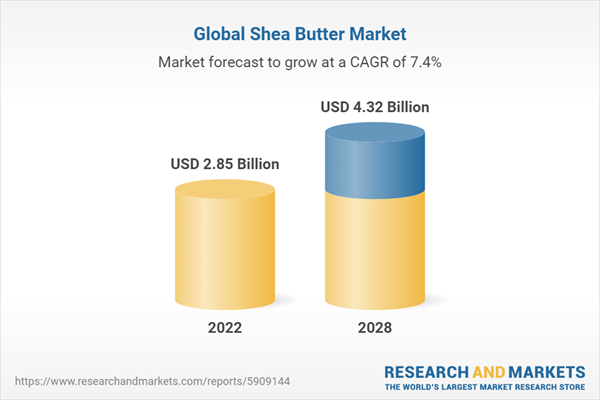Speak directly to the analyst to clarify any post sales queries you may have.
10% Free customizationThis report comes with 10% free customization, enabling you to add data that meets your specific business needs.
Shea butter, derived from the African tree nut Vitellaria paradoxa, contains saturated and unsaturated fatty acids, vitamins E, A, and F, as well as carotene. Vitamins E and A are known for their collagen-enhancing properties, soothing, and moisturizing effects on the skin. Shea butter serves as a suitable base for products designed to moisturize the skin and hair. It is commonly used in cosmetics as a moisturizer, salve, or lotion, renowned for its protective properties against environmental factors that can lead to dryness, irritation, and other skin issues. With both younger and older generations increasingly using cosmetics, the cosmetic shea butter market is expected to grow throughout the forecasted period, although competition from alternatives like mango butter and shea oil may limit its expansion.
Shea butter finds primary applications in the food, pharmaceutical, and cosmetic industries, offering enhanced benefits for skin and hair, including nourishment and moisturization. It is also used to treat conditions such as poison ivy, bug bites, dermatitis, and skin rashes. Moreover, it helps minimize fine lines and wrinkles, making it effective in treating rough skin.
As awareness of shea butter's therapeutic benefits for the skin, including its anti-aging properties, additional moisturizing qualities, and healing effects, continues to grow, market revenue is expected to increase. Furthermore, the preference for cosmetic products made with natural ingredients, particularly among women and young consumers, is anticipated to drive market growth in the future. The increasing number of product launches in the cosmetics and personal care segment is also expected to contribute to market growth during the forecasted period.
Key Market Drivers:
1. Growing Demand for Natural and Organic Products: The shea butter market benefits from increasing consumer preferences for natural and organic products. Consumers are seeking skincare, haircare, and food items that are free from harmful chemicals and synthetic additives. Shea butter's natural origin, nutrient-rich composition, and minimal processing make it an appealing ingredient for products aligned with this demand. It is widely used in personal care products like moisturizers, lip balms, and soaps, reflecting the shift towards nature-derived solutions for self-care routines.2. Nutritional and Health Benefits: Shea butter's nutritional and health benefits contribute significantly to its market growth. Rich in vitamins, antioxidants, and essential fatty acids, it is sought after in skincare formulations and dietary supplements. These components are believed to have anti-inflammatory, moisturizing, and skin-protective properties. In regions where shea butter is traditionally used, such as West Africa, it is also consumed for its potential health benefits, including cardiovascular support and immune system enhancement.
3. Beauty and Personal Care Industry: The beauty and personal care industry plays a pivotal role in driving demand for shea butter. Many cosmetic and skincare companies recognize the value of incorporating natural ingredients into their products, aligning with consumer preferences for sustainable and skin-friendly solutions. Shea butter's versatility in formulations positions it as a go-to ingredient for enhancing the texture and efficacy of personal care products.
4. Market Expansion: While shea butter is well-known for its applications in the cosmetic and personal care industries, its potential in the food and beverage sector is also driving market growth. In West Africa, shea butter is a traditional ingredient used in cooking, and its nutty flavor and nutritious properties have led to its inclusion in products such as chocolate, confectionery, and spreads. As consumers seek healthier and natural alternatives in their diets, shea butter's introduction into various food products provides a unique selling point for manufacturers.
The dynamic nature of the shea butter market is driven by continuous innovation in product development. Companies are investing in research and development to create new formulations and applications for shea butter, including shea butter-infused oils, butters, and serums for targeted skincare solutions. The market is also witnessing collaborations between cosmetic and food companies to create innovative cross-industry products.
International Trade and Export Opportunities: International trade and export of shea butter significantly contribute to the economic empowerment of producing regions, primarily in West Africa. Countries like Burkina Faso, Ghana, Nigeria, and Mali are major producers of shea butter. The revenue generated from export sales supports local economies, creates jobs, and improves livelihoods in rural communities where shea trees are cultivated and harvested. The global demand for natural and sustainable products, coupled with the unique qualities of shea butter, has led to increased trade between producing countries and international markets. This expansion is driven by several key factors that highlight the economic, social, and cultural significance of shea butter on a global scale.
As the global demand for natural, sustainable, and culturally significant products continues to grow, shea butter's international trade and export will likely remain a driving force in shaping its market expansion and contributing to the socio-economic development of producing regions.
Key Market Challenges:
1. Sustainability and Deforestation: Unsustainable harvesting practices pose a significant challenge in the shea butter market, potentially leading to deforestation and ecosystem degradation. Shea trees are vital for maintaining biodiversity and environmental balance in their regions. Initiatives promoting responsible harvesting and agroforestry practices are essential to mitigate these challenges.2. Quality and Standardization: Maintaining consistent quality standards is another challenge. Variations in processing techniques, storage conditions, and refinement levels can lead to differences in shea butter quality. Clear quality standards and rigorous testing processes are needed to address this issue.
3. Price Sensitivity and Affordability: Shea butter varies widely in price points, from budget-friendly options to high-end products. Balancing quality and affordability can be challenging, especially when using high-quality materials.
4. Limited Infrastructure and Technology: Limited access to modern processing technologies and infrastructure can hinder efficiency and quality in shea butter production. Investment in infrastructure and technological advancements is necessary to improve production efficiency.
5. Climate Change and Agricultural Resilience: Climate change poses challenges to shea tree ecosystems, affecting nut yields and impacting communities reliant on shea nuts for income and food security. Climate-smart agricultural practices can enhance resilience in shea tree ecosystems.
In conclusion, the shea butter market faces various challenges that need to be addressed to ensure its sustainability, quality, and positive impact on producing regions. Responsible harvesting, fair trade practices, quality standards, innovation, and infrastructure development are essential factors for overcoming these challenges and creating a more resilient and equitable market for both producers and consumers.
Key Market Trends:
1. Sustainability and Ethical Sourcing: Sustainability is reshaping the shea butter market, with consumers increasingly conscious of environmental and social impacts. Initiatives promoting ethical sourcing, fair trade, responsible harvesting, and biodiversity conservation are gaining traction.2. Natural and Clean Beauty Movement: The natural and clean beauty movement is driving demand for products aligned with health-conscious and eco-friendly values. Shea butter's natural origin and nutrient-rich composition make it a popular choice for skincare and haircare formulations.
3. Diversification and Innovation
: Shea butter's versatility is driving innovation across industries. It is finding applications in cosmetics, anti-aging serums, sunscreens, makeup, and the food sector, enhancing chocolate and confectionery products.4. Technological Advancements and Value Addition: Technology is modernizing shea butter production and sales channels. Innovations in extraction methods, e-commerce platforms, and traceability technologies are enhancing efficiency and transparency in the shea butter market.
Segmental Insights:
Product Insights: Raw and unrefined shea butter is the leading product category, expected to maintain its position throughout the forecast period. Consumers are increasingly interested in less processed oils due to their benefits, including skin moisture enhancement, wound healing support, and acne control. Raw and unrefined shea butter's versatility makes it suitable for various applications, including treating sunburn, rashes, frostbite, psoriasis, dry skin, itchy skin, and stretch marks.Application Insights: The food category holds the largest market share for shea butter globally. Shea butter's nutritional qualities make it popular in the food industry, serving as a natural antioxidant, trans-fat-free edible oil, food additive, and functional food ingredient. Its vitamins A, E, and F promote blood flow and healthy skin cell development. Shea kernel fat can replace dairy butter in various food products, further driving demand in the food industry.
Regional Insights: In 2022, Europe held the largest market share due to the presence of numerous cosmetics and pharmaceutical businesses. Shea butter is widely used in products like body lotions, moisturizers, and chocolates. Europe's ample supply of raw materials from Sub-Saharan African nations is expected to continue fueling market growth.
Report Scope:
In this report, the global shea butter market has been segmented into the following categories, in addition to the industry trends which have also been detailed below:Shea Butter Market, By Product:
- Raw/Unrefined
- Refined
Shea Butter Market, By Application:
- Cosmetics & Personal Care
- Food & Beverage
- Pharmaceutical
Shea Butter Market, By Sales Channel:
- Specialty Stores
- Online
- Convenience Stores
- Supermarkets/Hypermarkets
- Others
Shea Butter Market, By Region:
- North America
- United States
- Canada
- Mexico
- Europe
- France
- United Kingdom
- Italy
- Germany
- Spain
- Asia-Pacific
- China
- India
- Japan
- Australia
- South Korea
- South America
- Brazil
- Argentina
- Colombia
- Middle East & Africa
- South Africa
- Saudi Arabia
- UAE
- Turkey
Competitive Landscape
Company Profiles: Detailed analysis of the major companies present in the Global Shea Butter Market.Available Customizations:
Global Shea Butter Market report with the given market data, the publisher offers customizations according to a company's specific needs.This product will be delivered within 1-3 business days.
Table of Contents
Companies Mentioned
- BASF SE
- Olvea Group
- Sophim S.A.
- Cargill, Inc.
- Suru Chemicals
- Ghana Nuts Company Ltd.
- Croda International Plc
- Agrobotanicals, LLC
- Clariant AG
- AAK AB
Table Information
| Report Attribute | Details |
|---|---|
| No. of Pages | 190 |
| Published | November 2023 |
| Forecast Period | 2022 - 2028 |
| Estimated Market Value ( USD | $ 2.85 Billion |
| Forecasted Market Value ( USD | $ 4.32 Billion |
| Compound Annual Growth Rate | 7.3% |
| Regions Covered | Global |
| No. of Companies Mentioned | 10 |









